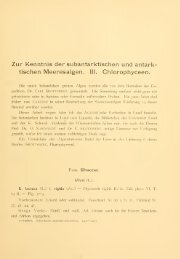Download PDF
Download PDF
Download PDF
You also want an ePaper? Increase the reach of your titles
YUMPU automatically turns print PDFs into web optimized ePapers that Google loves.
CHAPTER NINE<br />
THE GENUS MOUGEOTIA C. A. AGARDH 1824<br />
Plants belonging to this genus were figured and described as<br />
early as 1803 by Vaucher in his Histoire des Conferees. Agardh,<br />
however, was the first to classify these plants in a way that clearly<br />
distinguished them from other "conjugates." During succeeding<br />
years of the nineteenth century there was much confusion about<br />
the nature of the group of cells now called the spore, sporangium,<br />
and the gametangia. Some authors interpreted the group of cells<br />
as the spore; others thought the gametangia and conjugating tube<br />
constituted a "carpogonium." When the gametangia became<br />
divided by the sporangium walls, the ends of the gametangia were<br />
looked upon as "sterile cells," since they are not empty but contain<br />
"cytoplasmic residues." Hence, many descriptions until those of<br />
very recent years contain the statement that the spore, or "fertile<br />
cell," is adjoined by two, three, or four "cells" instead of two,<br />
three, or four dead ends of the gametangia. Apparently, because<br />
of the "residues," many authors could not see the complete homology<br />
between these reproductive structures and those of Zygnema.<br />
Because of the emphasis placed on the reproductive structures,<br />
the position of the "fertile cell" relative to the remnants of the<br />
gametangia became the basis of several genera which have been<br />
discarded by most authors. These generic names are only of<br />
historic interest and are listed at the end of the section. Plants of<br />
this genus are generally simple filaments of cylindric cells. Rarely<br />
one celled or two celled branches occur, particularly near the bases<br />
of filaments where the latter are anchored by coiling around a<br />
support or are attached to some substrate by rhizoids.<br />
The vegetative cells are comparatively long, five to twenty<br />
diameters, with plane end walls that are thinnest at the center.<br />
Hence when the cells of a filament separate, the free ends are<br />
usually somewhat conical. Each cell has one or two axial, flat<br />
chromatophores extending the full length of young cells but<br />
79




